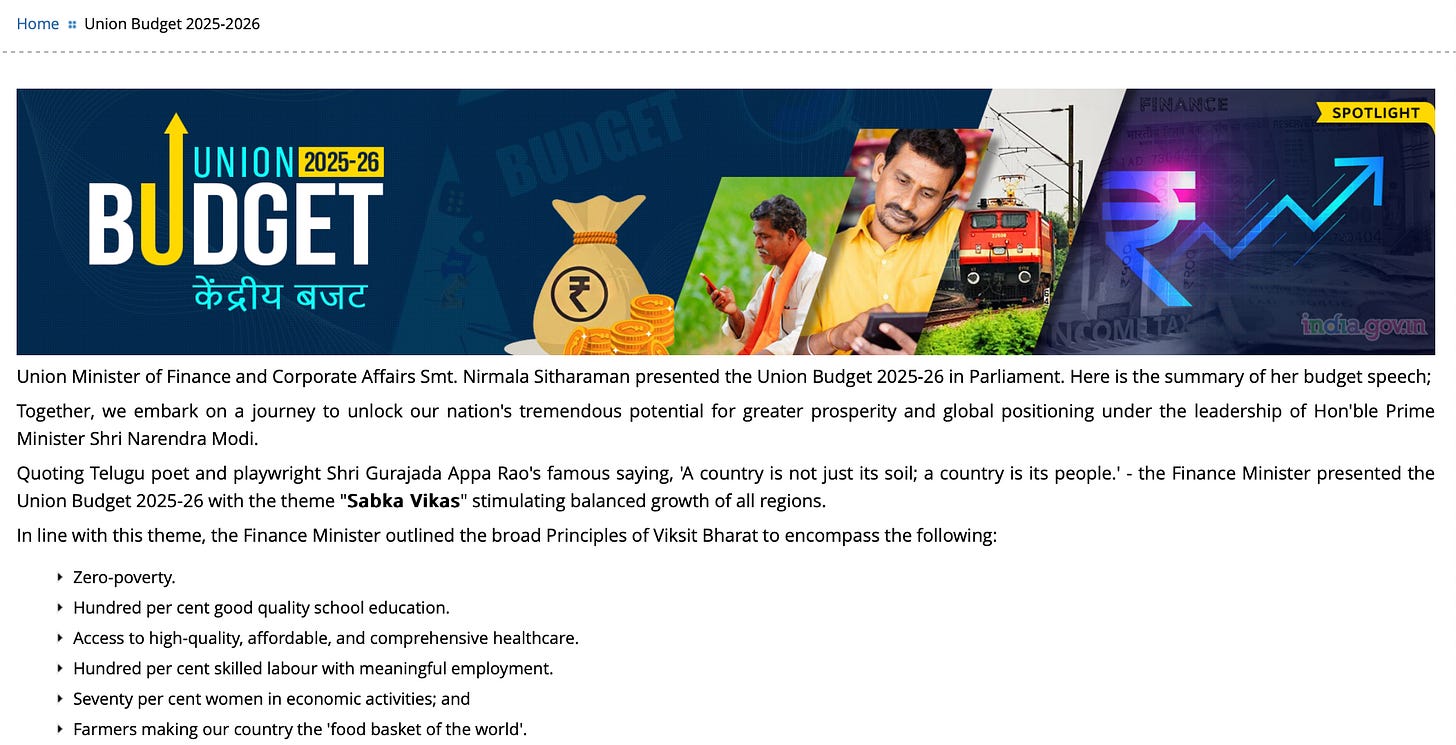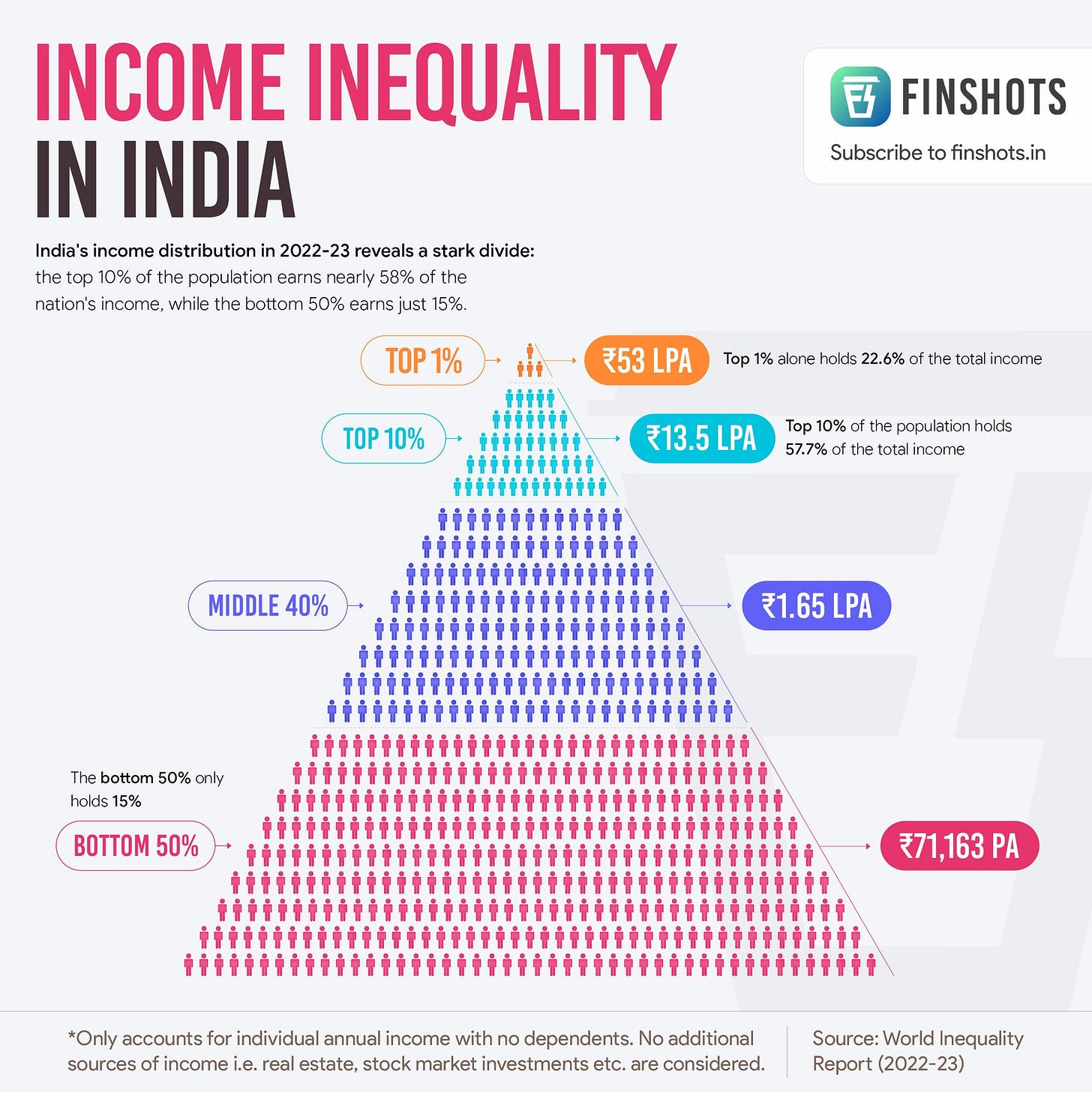The FY26 budget: A windfall for the affluent
An analysis of intended objectives, decisions made and possible consequences of the FY26 Union Budget.
Figure 1: Summary of the Union Budget 2025-26 objectives
Finance Minister Nirmala Sitharaman’s latest budget — the Union Budget 2025-2026 —ostensibly aims to help the government achievement its goal of a “Viksit Bharat” by ensuring “zero poverty… hundred percent good quality school education,” and “hundred percent skilled labour with meaningful employment,” among its principal socio-economic objectives. Given its aims, one would assume the budget would have been replete with proposals to provide a strong impetus to growth so that the rising tide of economic prosperity lifts all boats. It would also not have been remiss to expect that the spending and tax proposals would have all been aligned toward spurring job creation and broad-based consumption.
Paradoxically, however, the budget actively prioritises reduction in the fiscal deficit (to pre-COVID levels), with the projected total expenditure as a share of GDP actively declining year-over- year, from 16.01% in FY22 to 14.19% in FY26. Considering that the GDP of an economy is essentially a combination of government expenditure, private consumption spending, net exports and investment, the government’s push to curtail its spending creates downward pressure on the economy, leaving it to the other avenues to pick up the slack. A simple but crucial view of the average real rate of growth from 2020 to 2024 shows us that the economy (after accounting for the low-base effect from the pandemic) has grown at an average pace of 4.95%. It is then difficult to anticipate where the rising tide of economic growth might wash in from.
Figure 2: Total expenditure as a percentage of GDP (India)
The government’s capital expenditure as a percentage of GDP, as well as expenditure on education and rural development, have also stagnated. The absence of increases in physical capital and human capital investments bode ill for both the growth story and the “good quality” education and skilled employment narratives.
And the tax proposals, particularly on income tax, are completely at cross-purposes to poverty alleviation, leave alone eradication. With a stated objective of easing economic pressures on the “middle class”, the finance minister has in one stroke narrowed rather than widened the tax net by raising the level at which earners will start paying income tax to Rs. 12-lakh, from Rs. 7 lakhs currently. A quick look at the income data of Indians tells us that the average per capita income of Indians was Rs. 1.7 lakh as of the fiscal year ended in March 2023. By raising the exemption bar by an additional Rs. 5 lakhs, the Budget proposes to give a tax break essentially to the top 10% of earners in India.
Figure 3: Income distribution pyramid in India
If the minister had instead opted to utilise the about Rs. 1 lakh crore of revenue she is prepared to forego instead on cutting excise duty on petrol and diesel, the reductions in the price of the essential transportation fuels would not only help ease inflationary pressures but also leave more money in the hands of a substantially larger number of earners across the economy. This would include those in the gig economy driving Ubers, Olas, and Rapidos or delivering goods for Swiggy or Zomato as well as anyone using a personal vehicle to commute or transport produce, whether in a town or in the rural hinterland.
And a consequence of wanting to provide tax breaks to the ‘vocal class’ while also aiming to lower the fiscal deficit would be to add greater pressure on the average Indian via higher indirect taxes (GST – Goods and Services Tax). The tax burden of indirect taxes is always disproportionately heavier on the poor, who while not paying any income tax still end up paying taxes on all the essentials they consume, leading thus not to poverty alleviation but further immiseration.
Add to this, the proposals to cut basic customs duty rates on “yachts and other vessels for pleasure or sports” as well as on cars and motor vehicles including station wagons and racing cars costing more than $40,000 each and it would seem the Budget is focused on making life more affordable for the already rich and affluent.
The FY26 budget as proposed leaves plenty to be desired with respect to its stated objectives of reducing poverty, improving educational outcomes, increasing growth, and generating skilled employment. A budget that focuses more on human capital (education and healthcare), a push towards much-needed infrastructure development, and a progressive taxation system might do more in the way of achieving these aims than its current manifestation.
Disclaimer
This Substack does not provide investment advice.
The author is not a SEBI-registered investment advisor.
The content in this article is intended solely for informational and discussion purposes. It is not a recommendation to buy or sell any financial instruments or other products.
Investors should seek personalized advice from their tax, financial, legal, and other advisers regarding the risks and benefits of any transaction before making investment decisions.
The information provided in this article is sourced from generally available information It may be incomplete or summarized.
Investing in financial instruments or other products involves significant risk, including the potential total loss of the invested principal. This article and its author do not claim to identify all the risks or key factors associated with any transaction. The author of this website is not liable for any loss (whether direct, indirect, or consequential) that may result from the use of the information contained in or derived from this website.







THE TRUMP 2025 USA BUDGET
The Trump administration’s 2025 budget proposal presents a series of policy changes poised to adversely affect average Americans while disproportionately benefiting multinational corporations, CEOs, the wealthiest 1%, and GOP donors. This budget reflects a significant shift in economic priorities, favouring the affluent and undermining support systems for the broader populace.
Tax Cuts Favoring the Wealthy
Central to the budget are extensive tax reductions aimed at corporations and high-income individuals. These cuts are projected to widen the income disparity, granting substantial financial relief to the affluent while offering minimal benefits to middle and lower-income families. The reduction in corporate tax rates is anticipated to bolster profits for large enterprises, enriching CEOs and shareholders, many of whom are significant GOP donors.
Medicaid Reductions Impacting Vulnerable Populations
The budget proposes significant cuts to Medicaid, the federal program providing health insurance to low-income Americans. These reductions could lead to millions losing access to essential healthcare services, disproportionately affecting the most vulnerable populations. While some GOP members advocate for work requirements over spending cuts, the internal party conflict underscores a willingness to compromise public health to fund other priorities, such as tax cuts and border security.
Erosion of Labour Union Rights
In alignment with Project 2025, the administration seeks to undermine public-sector unions by prohibiting the use of federal funds for their operations. This move aims to weaken collective bargaining rights, diminishing the ability of workers to negotiate for better wages and working conditions. Such actions not only suppress workers’ rights but also serve to consolidate power among employers and corporate interests.
Tariffs and Trade Policies Affecting Consumers
The reintroduction of tariffs on imports from Canada and Mexico is intended to address trade imbalances and other geopolitical concerns. However, these tariffs are likely to lead to increased prices for consumers, as businesses pass on the additional costs. The resultant economic strain could disproportionately impact middle and lower-income households, further exacerbating economic inequality.
Reduction in IRS Workforce Benefiting Wealthy Tax Evaders
The initiative to cut 6,000 jobs at the Internal Revenue Service (IRS) is poised to hinder the agency’s ability to effectively collect taxes. This reduction could result in significant losses of revenue, estimated at $603 billion in uncollected taxes, primarily benefiting wealthy individuals and corporations adept at exploiting tax loopholes. Consequently, compliant taxpayers may bear the burden of this shortfall, undermining the fairness of the tax system.
In summary, the 2025 budget proposal appears to prioritize the interests of the affluent and corporate entities, including GOP donors, at the expense of regular Americans. The combination of tax cuts for the wealthy, reductions in social programs, erosion of labour rights, and policies favouring corporate interests suggests a governance approach that could exacerbate economic disparities and undermine the welfare of the general populace.
GQ